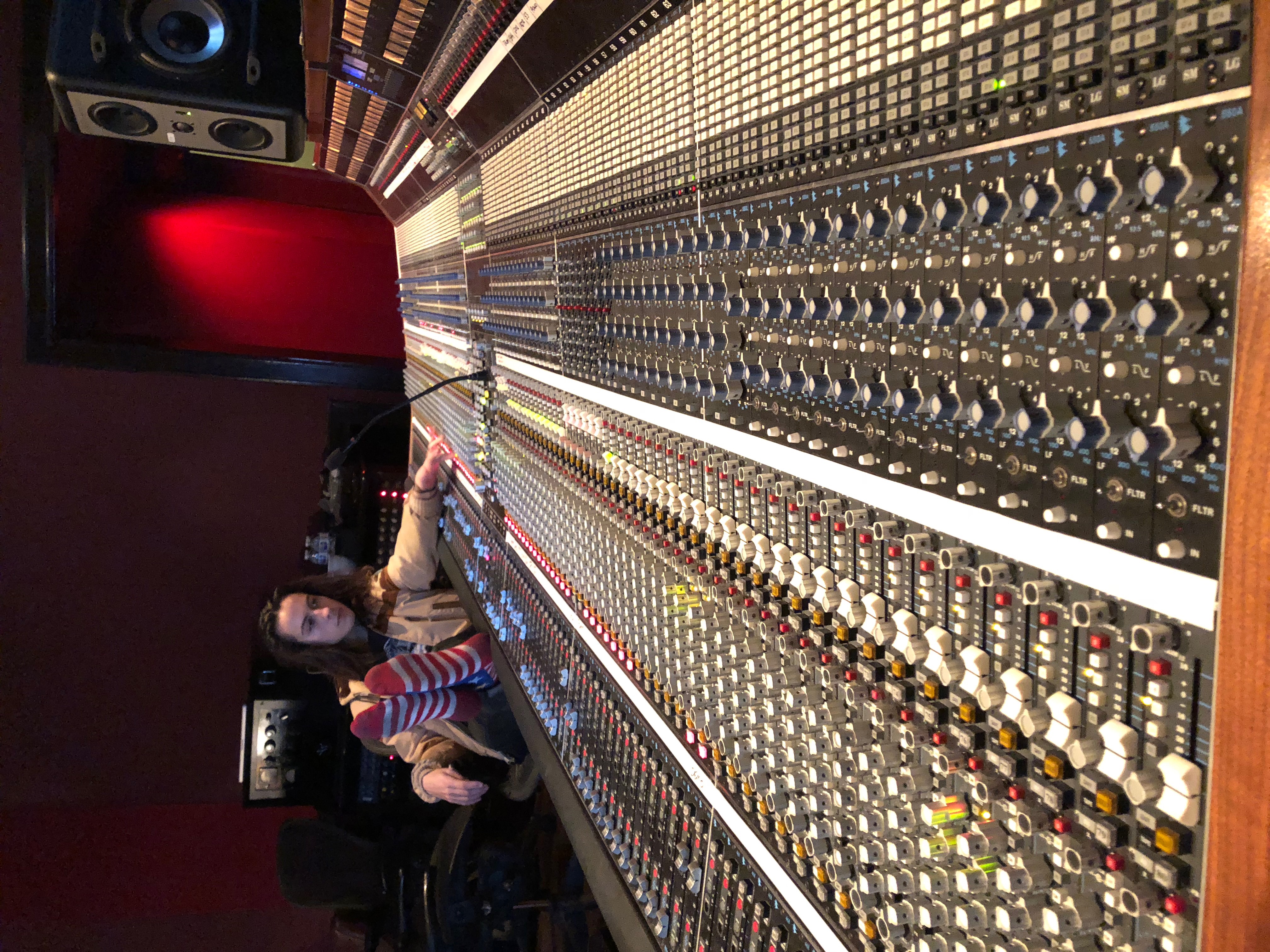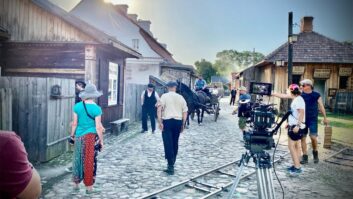Picking your way through the tombstones of the Hollywood Forever Cemetery for an intimate Apple Music performance from Greta Van Fleet seems particularly appropriate. The four-piece from the tiny town of Frankenmuth, Mich., shares much of the eerie yet beautiful mysticism that surrounds the elaborate, fog-laden resting places.
In the year and a half since the youthful Greta Van Fleet released its first single, the wailing “Highway Tune,” whose driving blues rock brought unavoidable Led Zeppelin comparisons, the group’s profile growth, and with it, fanbase, has been astronomical. Accomplished musicians and deft songwriters, Greta Van Fleet is heralded by Elton John, Ed Sheeran, Nikki Sixx and Justin Bieber, to mention just a few admirers.
Twin brothers Josh and Jake Kiszka (22) handle the vocals and guitars, respectively, while their younger sibling, Sam (19), plays bass and keys alongside drummer Danny Wagner, also 19. It was the latter two who had to forgo their prom as the band had a slew of tour dates to get through These nonstop shows have had a marked effect on the group’s musical skills, which already were formidable.
“When they came back after being on the road for six months and we got back in the studio, it was immediately noticeable that they had been playing four or five nights a week,” says Marlon Young, who, along with veteran audio engineer Al Sutton (Kid Rock) and Herschel Boone, have worked on all of Greta Van Fleet’s official recordings: Black Smoke Rising EP (2017), From the Fires EP (2017) and their debut full-length, Anthem of the Peaceful Army (2018).

The three masterminds, aka the Rust Brothers, sit at the 48-channel API Legacy console of their Rust Belt Studios in the Royal Oak suburb of Detroit. This is the same desk on which Sutton mixed Anthem of the Peaceful Army, with no digital interference in sight. The album was pre-produced and partially recorded at Rust Belt, where the EPs were recorded, and partially at Nashville’s Blackbird Studios. This was due to scheduling, but also to avoid the unavoidable distractions the band has in Detroit.
Some material was already written, some written in the studio; the project was recorded in two blocks of 10 days and seven days, a few weeks apart. The band was recorded together, live—primarily without a click—with the odd vocal or guitar solo overdub coming later.
“They’re not excited about 12-hour studio days,” says Sutton. “We’ll be working here, messing around with something, and we look up and they’re gone. We find them in the lobby, the four of them with acoustics, just jamming for hours on end. They’re in a constant jam session. They don’t want to sit here and do it, they want to be out there, with all four of them playing and singing. They never stop playing. It’s fascinating to watch.”
Related: All Access: Kid Rock, by Steve Jennings, Sept. 1, 2011
Adds Young, “There have been times in pre-production when we have a couple of mics up and we’re working on a song. You make a suggestion, they think about it, you go grab a coffee, walk back in, and they’re playing a different song. They can’t help themselves. It’s the most fun, most rewarding thing, though.”
A glimpse of this is captured in the Apple Music “Up Next” short film of Greta Van Fleet, where the group is sitting on stools in the middle of a field, rocking out acoustically like they would to an arena-sized audience. Growing up in a household of musical instruments with their parents’ vintage vinyl collection, it’s not a stretch to see the trajectory.
The Kiszka brothers are self-taught musicians, citing the “University of YouTube” as their alma mater, while Wagner had lessons and played in the school band. Josh Kiszka wasn’t looking to a career as a vocalist, instead working in a visual medium with theatrics and costumes—much of which is apparent in the band’s Eastern-influenced, stylized hippie presentation.

Young credits the human element of Greta Van Fleet as one of main factors that connects with audiences. The Rust Brothers keep that human element intact by not coloring it with too much studio manipulation, a sentiment the band—which isn’t enamored of studio toys—shares.
Jake Kiszka keeps his guitar sound clean, avoiding pedals for the most part and focusing on overdrive rather than distortion, in the same vein as the classic harder rock guitarists he grew up emulating. This time he played direct into a 1965 Vox AC-30 or Bletchley Bletchfire, a custom-made amp made by the Detroit-based Danny Russel, or Marshall Slant 25w. When he does use pedals, it’s either Electro-Harmonix Holy Grail reverb, Jext Telez Range Lord reverb or Jext Telez Jext Face fuzz.
Want more stories like this? Subscribe to our newsletter and get it delivered right to your inbox.
Sam Kiszka on keyboards, meanwhile, plays bass pedals with his feet while playing chords or piano with his hands. “[Sam] likes to experiment,” Sutton says. “He’ll grab any pedal and see how awful it can sound. When we were at Blackbird he discovered the storage locker with the Mellotron, the Rhodes, the Wurlitzer, the Clavinet, and by the second day all of it was set up in the keyboard isolation booth, which already had a Hammond B3 and a grand piano. He was in there all the time. It was amazing to see. And he managed to get the Clavinet onto ‘Mountain of the Sun.’”
Wagner’s drums, which are so prominent yet not at all overpowering, Sutton mikes using the Glyn Johns method: AKG D30 and RCA 44 on the kick, Shure SM57 and Gefell M300 on the snare, Sennheiser MD421 on the bottom snare, and 441 in the knee position, as well as room microphones.

For Josh Kiszka’s tremendous vocals—“He’s loud,” says Young—a Neumann 269 is used, as something like a U47 proves to be too bright for him. This goes through Acme Audio MTP-66 Motown tube pre and original Motown EQ. compressed via a Neve 32264.
Related: Memphis Meets Music City at House of Blues, by Tom Kenny, May 1, 2009
This simplicity in the capturing of the sounds serves Sutton well in the mixing stage. The tracks are split out into the API’s 48 inputs. Sutton uses fader automation and relies on the Barefoot MicroMain 27 monitors. “Very old,” he states of his approach. “We don’t use the computer at all. The songs are really open. It’s not sonically hard to battle. We just listened a lot and overanalyzed, but [Young] keeps me from getting too much tunnel vision.”
Young stays out of the studio during the mixing stage. Once Sutton has completed the mix to his satisfaction, Young listens to it on his headphones, in his stereo, in his truck, and comes back with his input, if any.
“It’s like they stepped out of 1976,” Young sums up. “The entire mentality to the music, the entire reason they do it, what they feel it stands for, the sounds they like, it’s not even that they’re trying to do it, it’s just who they are.”







